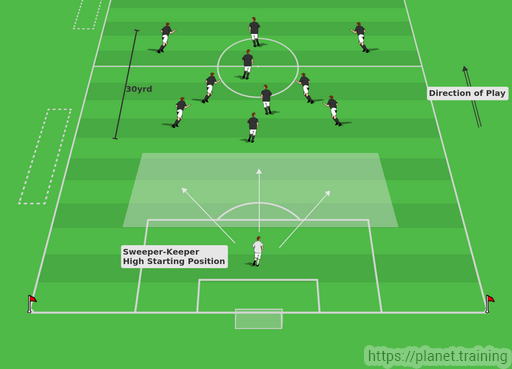WORLD CLASS COACHING
Tactical Series
Antonio Conte
By Jonny Carter and Michael J. Louter

TABLE OF CONTENTS
Part One
INTRODUCTION
THE CONTE CHANGE TO 3-4-3 AND WHY?
TRADITIONS AND CONVENTIONS OF THE 3-4-3 - BECKENBAUR
TRADITIONS AND CONVENTIONS OF THE 3-4-3 - CRUYFF
Part Two
TRADITIONS AND CONVENTIONS OF THE 3-4-3 - DEFENSIVE PHILOSOPHY
THE SHAPE OF PLAY
THE SHAPE OF PLAY - DEFENSE
Part Three
SHAPE OF PLAY - MIDFIELD
SHAPE OF PLAY - ATTACK
WEAKNESS OF THE 3-4-3 - TOTTENHAM 2 V 0 CHELSEA
ABOUT THE AUTHORS
INTRODUCTION
The 2016/17 Premier League season has been an epic endeavor with some of the best players and best coaches in world soccer gracing the very best clubs. Not only has the off-season off-field drama been most exciting and the on-field excellence a joy to watch, but there has been an undercurrent of tactical intrigue laced throughout the season this far. With some of the most strategic minds meddling with tradition and conformity the tactical chalkboard has been as refreshing as the soccer.
The story of Chelsea FC has been one of the most fascinating of them all. From running away league champions in 2014/15 to manager-less mid-table mediocrity in 2015/16 to renewed title winning favorites again. Along that tumultuous journey a change of leadership and a change in formation have seen Chelsea FC revive a traditional system of play with almost record-breaking success. Antonio Conte’s 3-4-3 system of play is rocking the Premier League with Chelsea FC sitting handsomely at the top of the table after 22 games played.

Premier League Table | Monday 23rd January 2017
The Conte Change To 3-4-3 | Why?
Antonio Conte has enjoyed an illustrious playing career and is now enjoying an illustrious journey into coaching as well. As the head coach at Italian giants Juventus FC Conte was very successful, winning triple back-to-back domestic league titles and a couple of other notable trophies as well.
As head coach of the Italian national team Conte also earned respect rather than success when he very much made the most of an average squad of players.
For the vast majority of his coaching time with Juventus FC and with the Italy national team Conte would play with a three man defensive group. Often more in a 3-5-2 system of play, but a three man defensive group all the same.
It was somewhat of a surprise that Conte didn’t implement this strategy straight away when he took over at Chelsea FC after the Euro 2016 summer tournament, instead rather choosing to keep continuity with the old regime and persist with the old style Chelsea FC of 4-2-3-1. Early fortunes were mixed despite a rather helpful fixture list of games. Then back-to-back defeats at Liverpool FC and Arsenal FC spelled a necessity for change.
On Saturday 24th September 2016 Chelsea FC traveled to the Emirates Stadium to play a Premier League game against a potential title rivals, Arsenal FC. As had been the norm under Conte so far in the season, Chelsea FC set up with the same mixed success, 4-2-3-1 formation. By halftime Arsenal FC had destroyed Chelsea FC, scoring three goals and dismissing them with contempt. The final score of 3-0 was fair reflection of Arsenal FC’s dominance and this event was a catalyst for Chelsea FC change that was almost unprecedented.
In fact, the change came in the second half of this game, though the result remained as decisive.

During the second half, Conte chose that this was his moment to forget the past Chelsea FC regime and introduce the new Chelsea FC. Conte reverted to a three man defensive group after 55minutes of this game, signaling a significant shift in his future strategy. On to the field came Marcos Alonso, a summer signing from Italian club ACF Fiorentina, a player who Conte would have had good knowledge of. However, most importantly, this change finally permitted a left-footed player to operate on the left side of the Chelsea FC team, either as fullback, wingback or a midfielder. The switch shifted the right foot dominant César Azpilicueta out from the left fullback role and into a more familiar position on the right side of the Chelsea FC team. This reclaiming of balance in the formation was the catalyst for a Chelsea FC revival.
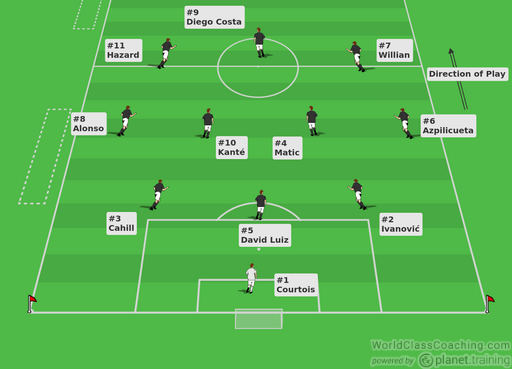
The shift to a 3-4-3 system of play with left footed and right footed wingbacks appropriately positioned to their natural side of the field proved a turning point for Conte and his Chelsea FC team. The 0 - 0 second half could not stop the inevitable defeat but the tide of change had been cast.
Conte’s post match words following the debacle also suggested that change to the Chelsea FC system of play was imminent.
"After today we are thinking we must work a lot because we are a great team only on paper. It is always a team problem rather than individuals, when nothing works it is very hard for a player to play well…
If someone thinks this team is ready to fight, I think we must wait to improve a lot to come back a great team on the pitch, not just on paper…
We have not got the balance and now is the moment to consider everything. It is incredible to concede three goals…
We must reflect a lot to find very soon the right way." Antonio Conte
In the next Premier League game, away versus Hull City FC a week later, a revised Chelsea FC was witnessed. The now familiar Chelsea FC lineup of formation and of personnel was unveiled. Marcos Alonso started in the #8 Left Midfield position and the perennially out-of-favor Victor Moses came into the #6 Right Midfield position. Branislav Ivanović was dropped from the team altogether, with César Azpilicueta assuming the #2 Right Central Defender role.
For the first time the new look Conte’s 3-4-3 Chelsea FC was seen. The game was far from a classic as the new system of play took time to settle and the radically new players to the first team grew into their status. Chelsea FC ran out 0 – 2 winners with Victor Moses claiming a man-of-the-match performance.
This new Chelsea FC 3-4-3 formation, and pretty much these exact players, would carry the club on a near record breaking winning streak of 13 Premier League victories. The triumphant run only recently halted by a fantastic Tottenham Hotspur FC team when they beat Chelsea FC 2 – 0 at White Hart Lane on Wednesday evening 4th January 2017.
Perhaps the biggest irony was that Tottenham Hotspur FC had only recently changed their own system of play to copycat Chelsea FC’s all-conquering 3-4-3. We’ll analyze how they did that a little later.

Hull City FC vs. Chelsea FC
Traditions & Conventions of the 3-4-3
While the Premier League has seen pretty much every formation and system of play at some time or another, there really has not been that much strategic attention given by coaches to a three man defensive group. And when three man defensive groups have been deployed it has most often been with a 3-5-2 formation; very few coaches have been brave enough to set up their teams to play with a 3-4-3 formation against such a competitive league.
While Chelsea FC’s recent introduction of the 3-4-3 formation might be regarded as new to the contemporary soccer fan watching the Premier League, there has been quite a tradition of teams earning great success and acclaim with the 3-4-3, we explore some of the most salient examples of soccer history.
Traditions & Conventions of the 3-4-3 | Franz Beckenbauer
World Cup winning captain and coach, and all round soccer legend, Franz Beckenbauer initiated many developments and re-developments of the modern tactical game. Through the late 1960’s & ‘70’s Franz Beckenbauer pioneered many tactical nuances particularly with his ubiquitous connection to the ‘libero’. Beckenbauer possessed a unique talent and unprecedented game-play understanding which allowed him to bring the ball out from a sweeper position in a recognizable four man defensive group. Beckenbauer could join into the midfield and dictate the tempo of the game from there leaving a three man defensive group behind him.

Nicknamed ‘Der Kaiser’ (The Emperor), Franz Beckenbauer was able to influence an entire generation of soccer strategy with his elegant ball-playing ability, tactical understanding and a leadership that would carry him through captaincy and into World Cup winning coaching.
Traditions & Conventions of the 3-4-3 | Johan Cruyff
Johan Cruyff is another true soccer legend who has transcended mere playing excellence but is also recognized as one of the most ingenious tactical minds. With a playing heritage unparalleled, Cruyff was truly a product of a strategy-centric environment. Under the schooling of the much fabled Rinus Michels; voted FIFA Coach of the Century in 1999; and a product of the revered AFC Ajax development conveyer belt, Cruyff was a true master of the playing field and the chalkboard.
Cruyff’s playing days were refined within the revolutionary Dutch national team of the late 1960’s & ‘70’s under the guidance of Michels and with his time as an FC Barcelona icon as a player and as a coach. Cruyff was the on-field brains and the physical incarnation of much of the Michels master plan conceived in the mind of a genuine tactical genius. This relationship between playing pupil and strategic mentor would be replicated further down the road as Pep Guardiola and Cruyff embarked on their own FC Barcelona legacy of the 1990’s.
Johan Cruyff’s return to FC Barcelona as head coach brought almost immediate success. After such a strong apprenticeship as a player and with some durable coaching education learned back at AFC Ajax, Cruyff was ready to take on the FC Barcelona job.
Cruyff’s strategy was to impalement his much admired aggressive attacking style wrapped up in the 3-4-3 system of play. The success was almost instant.
However, when comparing the detail of the 3-4-3 deployed by Johan Cruyff during his FC Barcelona days with that of the 2016/17 Chelsea FC team, there are differences. Both utilize the 3-4-3 formation on paper, but on the field there is a large variance.
The similarities are that the number of players within each group is the same; 3 defenders, 4 midfielders and 3 forwards.
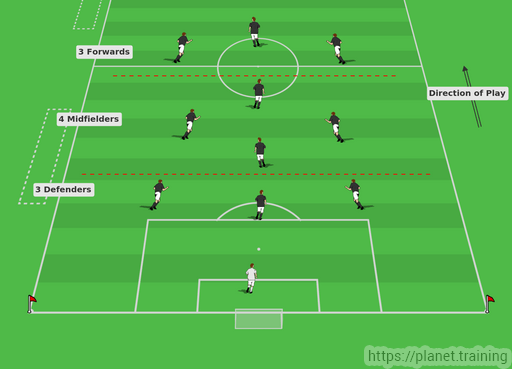
The three defenders deployed in a recognizable fashion; #2 Right Central Defender, #3 Left Central Defender & #5 Central Defender. The three forwards are also deployed in a recognizable fashion; #7 Right Forward, #11 Left Forward & #9 Center Forward. Of course there is a #1 Goalkeeper.
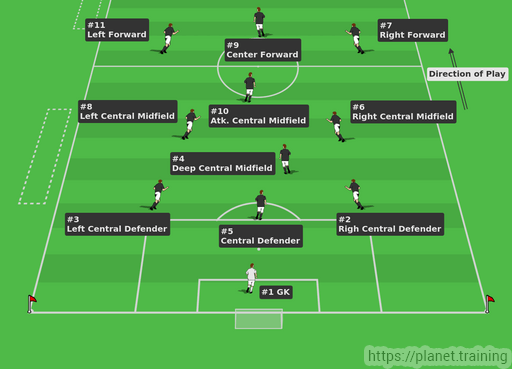
However, the differences come with the deployment of the midfield four. Johan Cruyff recognized that almost every opposition was setting up with the rather predictable 4-4-2 system of play against them. With only two central forwards in opposition it was thought that FC Barcelona didn’t need four players in their defensive group to cope with them. Three defenders versus the two opposition central forwards were easily enough to man-mark and leave a free player to provide cover. This opened up opportunity to add an additional player to the midfield group without compromising the very attack-minded front three, a signature of Cruyff’s relentless pursuit of aggressive offensive soccer.
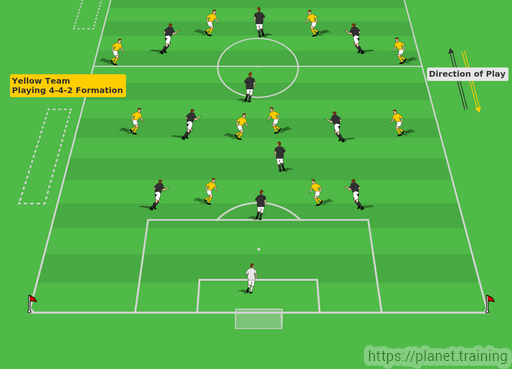
It might be assumed that the player coming out of the defensive group and into the midfield might be a robust, destructive player designed to screen and protect the now back three. But this was not Johan Cruyff’s method. Instead of merely pushing a defender forward into midfield he decided to use a true passer of the ball and monopolize possession.
Pep Guardiola was that chosen player. Diminutive in size but cultured in technique, Guardiola assumed that #4 or ‘pivot’ role with great distinction. Able to collect the ball from the goalkeeper or from the defensive group the ‘pivot’ can initiate the tempo of the game and build the attacking phases. Playing very central down the spine of the field with positional discipline; and with intelligent, subtle movement creating endless angles of support, Guardiola was able to deliver the game plan that Cruyff had devised.
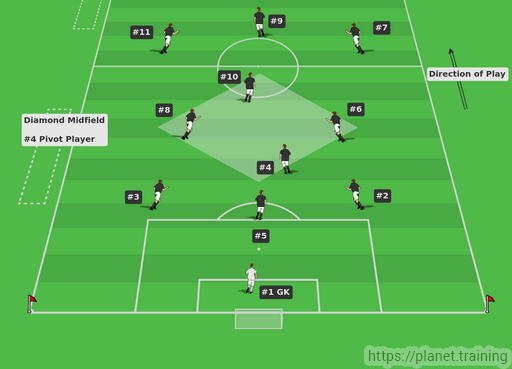
The other deployment of the midfielders is also different under Cruyff’s mid 1990’s FC Barcelona team compared to the 2016/17 Chelsea FC; while Chelsea FC stretch their wing-backs/wide midfielders the full width of the field, FC Barcelona played with a very narrow midfield diamond.
The Left Central Midfielder #8 and the Right Central Midfielder #6 played very much inside and connected to the midfield group. Ahead and at the point of the diamond the #10 Attacking Central Midfielder could link midfield with the forward group who could provide great width as a front three.
The close proximity of the midfield group ensured that passing options were always near and available, and the quality of the player’s technique good enough to thrive in this demanding part of the field.
The connectedness of the midfield four also helped on the rare occasions when possession was relinquished; large clusters of players could quickly go hunting for lost possession before the opposition could build their attacking principles.
This super-positive style of play was very much predicated on the retention of possession, depriving the opposition of the ball rendering defense less of a necessity. If you have the ball then it’s tough to be scored on. And with Pep Guardiola masterminding the #4 ‘pivot’ from the base of the diamond the FC Barcelona 3-4-3 won plenty of games and plenty of trophies.
It is worth noting that these field plans are diagrammatical representations designed to provide a clear picture by simplifying the tactical concepts. In reality the distances between the groups would be much closer, something like 30 – 35yrds between the deepest defender and the highest forward.
The goalkeeper assuming a very high and aggressive starting position with a sweeper-keeper philosophy ready to clean up any longer, direct balls behind the defensive group.
